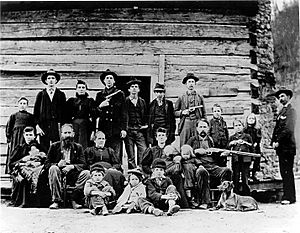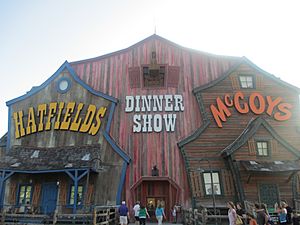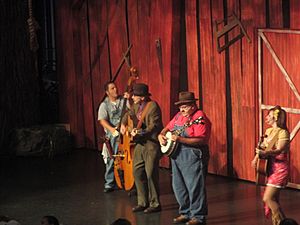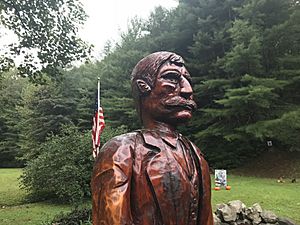Hatfield–McCoy feud facts for kids
Quick facts for kids Hatfield–McCoy feud |
|||
|---|---|---|---|
|
Hatfield–McCoy feud site along the Tug Fork tributary (right) in the Big Sandy River watershed
|
|||
| Date | 1863–1891 | ||
| Location |
Tug Fork of the Big Sandy River, West Virginia–Kentucky
|
||
| Caused by | American Civil War, land disputes, revenge killings | ||
| Resulted in |
|
||
| Parties to the civil conflict | |||
|
|||
| Lead figures | |||
|
|
|||
The Hatfield–McCoy feud was a long and bitter conflict between two families in the United States. It took place in the rural areas of West Virginia and Kentucky, along the Tug Fork of the Big Sandy River. The feud lasted for many years, from 1863 to 1891.
The Hatfields of West Virginia were led by William Anderson "Devil Anse" Hatfield. The McCoys of Kentucky were led by Randolph "Ole Ran'l" McCoy. Both families were descended from early settlers, Joseph Hatfield and William McCoy. This famous feud has become a well-known story in American folklore. It is often used to describe any two groups that are fiercely fighting each other.
The McCoy family mostly lived on the Kentucky side of the Tug Fork river. The Hatfields lived mostly on the West Virginia side. Most Hatfields and McCoys fought for the Confederacy during the American Civil War. However, Asa Harmon McCoy from the McCoy family fought for the Union.
The first major violence in the feud happened when Asa Harmon McCoy was killed. He was murdered by a group of Confederate Home Guards called the Logan Wildcats after returning from the war. While Devil Anse Hatfield was first suspected, it was later believed that his uncle, Jim Vance, a member of the Wildcats, committed the murder.
The Hatfields were generally wealthier than the McCoys and had more political connections. Anse Hatfield's timber business brought his family a lot of money. The McCoys were a more middle-class family. Both families were also involved in making and selling illegal moonshine, which was a common activity at the time.
Contents
The Feud Begins
Civil War Connections
Asa Harmon McCoy joined the Union Army on October 20, 1863. He was captured by Confederate soldiers and later released to a hospital. During the early Civil War, Asa was wounded while serving in a local guard unit.
Around the same time, a friend of Devil Anse Hatfield, Mose Christian Cline, was shot by a group of Pike County Guards. Anse Hatfield promised to get revenge for this. In 1863, a group of Confederate Home Guards attacked and killed William Francis, a leader of the Pike County Guards. Anse Hatfield claimed responsibility for this act.
Asa Harmon McCoy was killed near his home on January 7, 1865, shortly after leaving the Union Army. His wife's pension application stated he was "killed by Rebels." The McCoy family believed that James "Jim" Vance, Anse's uncle, was the one who killed Asa.
Hog Dispute and Escalation
Thirteen years later, in 1878, the feud flared up again over a hog. Floyd Hatfield, a cousin of Anse, owned the hog. But Randolph McCoy claimed it was his, saying the marks on the pig's ears were McCoy marks. The local Justice of the Peace, Anderson "Preacher Anse" Hatfield, decided in favor of the Hatfields. This was based on the testimony of Bill Staton, a relative of both families.
In June 1880, Bill Staton was killed by two McCoy brothers, Sam and Paris. They were later found not guilty, as they claimed it was self-defense.
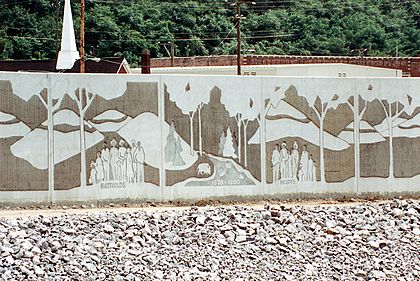
The feud grew worse when Roseanna McCoy fell in love with Devil Anse's son, Johnson, known as "Johnse." Roseanna left her family to live with the Hatfields. She later returned to the McCoys. When she and Johnse tried to be together again, Johnse was arrested by the McCoys for selling illegal alcohol.
Roseanna rode at night to warn Anse, who then organized a rescue party. The Hatfields surrounded the McCoys and took Johnse back to West Virginia. Despite Roseanna's actions to help him, Johnse later left her for her cousin, Nancy McCoy, whom he married in 1881.
Ellison Hatfield's Death
The feud continued in 1882 when Ellison Hatfield, Anse's brother, was killed. Three of Roseanna's younger brothers—Tolbert, Phamer, and Bud—were involved. On an election day in Kentucky, the three McCoy brothers fought Ellison and another Hatfield brother. Ellison was stabbed many times and then shot.
Hatfield law officers arrested the McCoy brothers and took them towards Pikeville for trial. But Anse secretly gathered a large group of vigilantes. They stopped the officers and took the McCoy prisoners by force to West Virginia. When Ellison died from his injuries, the Hatfields killed all three McCoy brothers. They tied them to trees and shot them many times.
Even though many in the area thought the Hatfields' revenge was fair, about twenty men, including Anse, were accused of crimes. All the Hatfields avoided arrest. This made the McCoy family very angry. They went to Perry Cline, who was married to Martha McCoy. Cline used his political connections to bring back the charges and offer rewards for the Hatfields' arrests. Cline had also lost a land lawsuit against Anse a few years earlier, which added to the hatred between the families.
In 1886, Jeff McCoy killed a mail carrier named Fred Wolford. Cap Hatfield, acting as a law officer, pursued Jeff. Cap and a friend, Tom Wallace, shot Jeff while he was trying to escape near the Tug Fork. Tom Wallace was found dead in the spring of 1887.
New Year Massacre
The feud reached its most violent point during the 1888 New Year's Night Massacre. Cap and Vance led several Hatfields to surround the McCoy cabin. They opened fire on the sleeping family. The McCoys woke up and fired back. The Hatfields then set the cabin on fire to force the McCoys out.
Randolph McCoy managed to escape and hide. Most of his children also escaped into the woods. Sadly, two of Randolph's children, Calvin and Alifair, were shot and killed as they left their home. Randolph's wife, Sarah, was caught and badly beaten. With their house burning, Randolph and his remaining family escaped further into the wilderness. His children suffered from frostbite because they were not prepared for the cold. The remaining McCoys moved to Pikeville to escape further attacks.
Battle of Grapevine Creek
Between 1880 and 1891, the feud caused the deaths of more than a dozen family members. At one point, the governors of West Virginia and Kentucky even threatened to send their state militias into each other's states. Kentucky Governor S. B. Buckner sent his Adjutant General, Sam Hill, to investigate the situation in Pike County.
A few days after the New Year's Massacre, a group led by Pike County Deputy Sheriff Frank Philipps went into West Virginia to find Anse's group. Two McCoys, Bud and James "Jim" McCoy, were part of Philipps' group. Their first victim was Vance, who was killed when he refused to be arrested. Philipps then raided other Hatfield homes, capturing many and killing three more Hatfield supporters.
On January 19, Philipps cornered the rest of the Hatfields at Grapevine Creek. However, Anse and other Hatfields were waiting with their own armed group. A battle broke out. The Hatfields were eventually caught. A deputy, Bill Dempsey, was wounded and then killed by Frank Philipps after surrendering.
On August 24, 1888, eight Hatfields and their friends were accused of murdering Alifair McCoy, Randolph's young daughter, who was killed during the New Year's Massacre. These included Cap, Johnse, Robert and Elliot Hatfield, Ellison Mounts, French Ellis, Charles Gillespie, and Thomas Chambers.
The Trial and Hanging
The case went all the way to the United States Supreme Court because of questions about legal procedures. The Supreme Court decided that Kentucky could try the men, even if they were brought back from West Virginia without proper legal steps.
Eventually, the men were tried in Kentucky and all were found guilty. Seven received life imprisonment. The eighth, Ellison "Cottontop" Mounts, was executed by hanging. Thousands watched his hanging in Pikeville. With his last words, Ellison claimed that "The Hatfields made me do it." No one had been hanged in Pike County for forty years before him, and no one was ever hanged there again after him.
Of those sent to prison:
- Valentine "Uncle Wall" Hatfield, Anse's older brother, died in prison. He had asked his brothers for help to get out of jail, but they did not come, fearing capture.
- Doc D. Mahon, Valentine's son-in-law, served 14 years in prison before returning home.
- Pliant Mahon, Valentine's son-in-law, also served 14 years before returning home.
Fighting between the families became less frequent after Mounts' hanging. Trials continued for years, with the last feud trial being Johnse's in 1901.
Hatfields and McCoys Today
In 1979, the families came together for a special week on the game show Family Feud. They played for a cash prize and a pig. The McCoy family won the week-long series.
Tourists visit West Virginia and Kentucky each year to see places related to the feud. In 1999, a big project called the "Hatfield and McCoy Historic Site Restoration" was finished. Many improvements were made to feud sites. A special audio CD, the Hatfield–McCoy Feud Driving Tour, helps visitors explore the sites. It includes maps and pictures, leading visitors to gravesites, the "Hog Trial Cabin," Randolph McCoy's home, and other important locations.
Great-great-great-grandsons Bo McCoy and Ron McCoy organized a joint family reunion of the Hatfield and McCoy families in 2000. More than 5,000 people attended.
In 2002, Bo and Ron McCoy filed a lawsuit to get access to the McCoy Cemetery. This cemetery holds the graves of six family members, including five killed during the feud. They took action against a private property owner who had limited access to the cemetery.
In the 2000s, a 500-mile all-terrain vehicle trail system, the Hatfield–McCoy Trails, was created around the feud's theme.
On June 14, 2003, in Pikeville, Kentucky, the McCoy cousins and Reo Hatfield declared an official truce between the families. Reo Hatfield said he wanted to show that if these two families could make peace, others could too. He wanted to send a message that Americans can put differences aside when national security is at risk.
More than sixty descendants signed the truce during the fourth Hatfield–McCoy Festival. It was called a proclamation of peace. Governor Paul E. Patton of Kentucky and Governor Bob Wise of West Virginia signed proclamations declaring June 14 Hatfield and McCoy Reconciliation Day.
The Hatfield and McCoy Reunion Festival and Marathon are held every June. The events take place in Pikeville, Kentucky, Matewan, West Virginia, and Williamson, West Virginia. The festival celebrates the famous feud and includes a marathon, ATV ride, and a tug-of-war across the Tug Fork river. There are also live re-enactments, tours of feud landmarks, and other fun activities. The festival started in 2000 and attracts thousands of people.
In August 2015, members of both families helped archeologists dig for ruins where they believe Randolph McCoy's house was burned.
In September 2018, a wooden statue of Randolph McCoy, over 8 feet tall, was put up at the McCoy homeplace in Hardy, Kentucky. This statue was carved by Travis Williams and given to the property by Bob Scott, a Hatfield descendant and property owner. The statue was unveiled during Hatfield-McCoy Heritage Days, an event that brings descendants back to Pike County to celebrate the peace between the families. The McCoy homeplace is open to tourists all year.
Media Portrayals
The Hatfield–McCoy feud has inspired many movies, TV shows, and books.
Film
- The 1923 Buster Keaton comedy Our Hospitality features a similar feud between the "Canfield–McKay" families.
- The 1938 Merrie Melodies cartoon A Feud There Was shows a feud between the Weavers and McCoys, with Egghead trying to make peace.
- The 1949 film Roseanna McCoy tells a fictional story of the romance between Roseanna McCoy and Johnse Hatfield.
- The 1950 Warner Bros. cartoon Hillbilly Hare spoofs the feud with Bugs Bunny and the "Martin family."
- The 2012 film Hatfields & McCoys: Bad Blood stars Jeff Fahey and Christian Slater.
Literature
- The Lucky Luke comic Les Rivaux de Painful Gulch (The Rivals of Painful Gulch) from 1962 was inspired by the feud.
- Ann Rinaldi wrote a 2002 historical novel called The Coffin Quilt, which is a fictional story based on the feud.
Television
- The Flintstones had an episode called "The Flintstone Hillbillies" (1964) about the Hatrocks and Flintstones, based on the feud.
- A 1975 TV movie, The Hatfields and the McCoys, starred Jack Palance as "Devil Anse" Hatfield.
- An episode of Time Squad (2001) called 'Feud For Thought' shows the team trying to restart the feud when the McCoys become peaceful.
- The History Channel aired a three-part miniseries Hatfields & McCoys in 2012. It starred Kevin Costner as Devil Anse Hatfield and Bill Paxton as Randolph McCoy. This miniseries became very popular.
- The reality TV series Hatfields & McCoys: White Lightning (2013) follows the families trying to start a legal moonshine business together.
- An episode of Modern Family (2014) features a dodgeball game where teams are called Hatfields and McCoys.
- My Little Pony: Friendship Is Magic (2015) had an episode called "The Hooffields and McColts" about two feuding clans.
- The Ben 10 reboot (2016) has an episode called "Them's Fighting Words!" which parodies the feud.
Music
- The song "The Hatfield and the McCoy's" by Eddie Martin is about the feud.
- Dave Adkins' 2018 song "Blood Feud" retells the story.
- Ice Cube's 1991 song "My Summer Vacation" and Waylon Jennings' 1977 song "Luckenbach Texas (Back To The Basics Of Love)" both mention the Hatfields and McCoys.
Theater
- A dinner show based on the rivalry has been performed year-round in Pigeon Forge, Tennessee since 2010.
|
See also
 In Spanish: Conflicto entre los Hatfield y los McCoy para niños
In Spanish: Conflicto entre los Hatfield y los McCoy para niños



